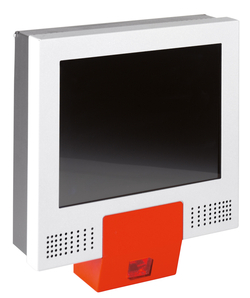
XKiosk - Individual application
Beautiful shell, hard core: industrial computers as patient purchasing consultants
Which hoover bag is the right one? Is this music CD to my taste? Everyday items such as music CDs, audio books, hoover bags and ink cartridges always give rise to questions for the inclined buyer. Questions that not every sales advisor can answer straight away in view of the growing flood of products. This problem is now solved by computer systems that can be found as kiosk applications in almost all large retail stores. But they can do much more.
Shoppers are increasingly encountering these patient digital sales advisors in bricks-and-mortar retail stores. However, they rarely realise the technical expertise that goes into the PC systems. The computers must have an extremely robust housing that reliably protects the inner workings from shocks and vibrations. The touchscreen and barcode reader must remain operational and resilient even under very frequent and heavy use. In addition, the kiosk application should be visually appealing and integrate perfectly into the respective shop fitting concept.
In addition to classic industrial solutions for the automation sector, the industrial computer manufacturer tci has been developing and planning customised solutions for a wide range of applications for many years. The aim is to find the best possible computer solution for demanding tasks in close cooperation with the client. Special environmental conditions such as high dust levels in print shops, warm production halls or limited space in production rooms require a customised and sophisticated solution concept. It all starts with the development of prototypes, which are tested with the customised equipment. Depending on the requirements, state-of-the-art PC technology or economical solutions with long-term availability are used. The OEM solutions can also be customised with your own design and logo. In this way, an OEM system developed by tci becomes the client's own product.
Project planning, design and development
The long-standing in-house designer at tci-Computer created his own design for the XKiosk application, which served tci as a template for the design. The task was to design a multimedia PC for the point of sale (POS) with clear differentiation from the competition. It had to be robust and durable, easy and self-explanatory to use and have a high-quality appearance. After extensive research in the markets and a targeted survey of potential users, the design development was carried out exclusively in three dimensions with the help of view models. In close and uncomplicated co-operation between tci's development department and the designer, this approach enabled quick decision-making. The total development time was only two months. In the course of development, decisive improvements were made from model to model (6 models in total). The large depth of the housing, which was due to technical reasons, was significantly reduced visually through design measures (model 4). The scanner, which was initially still integrated into the housing (models 1-4), was formally 'decoupled' from the housing as an independent technical element (model 5). This reduces the overall size of the housing, makes the scanner more recognisable for the customer and increases the mobility of the goods underneath the scanner. In a final step, the speech intelligibility and stereo effect of the speakers was audibly optimised by optimising the speaker openings (amplification of the secondary waves). The designer explains this approach: "The formal element brought movement and emotion to the front of the device at the same time. As a result, the optimum combination of function and emotion conveys the effect of the software to customers through the design alone and encourages them to operate and use the multimedia PC. Today, XKiosk computer systems and scan boxes (without display) from tci are already in use in many large electronics stores in Europe and beyond. Other areas of application include DIY stores, department stores and office centres.
POI - Point of Information for the retail trade
The kiosk systems are placed at central, highly frequented points in markets or at trade fairs. Customers select the desired product on the touchscreen monitors using various selection criteria and receive a wealth of additional and background information, which is presented using multimedia elements (graphics, audio, video). Many service functions are conceivable: For example, a location or department map can show the way to the product or service being searched for. Other service information or additional modules and features that are available for integration include Couponing, a loyalty card function, email, ordering service, gift advice and cross-selling. In the music product area, for example, the program provides an overview of the current CDs and the complete back catalogue. Searches can be carried out by title, artist, genre, individual song titles, using the charts or with the barcode scan function.
Visitors to a bookshop in Mainz can use the audio book information system to obtain up-to-date information on all audio books available in stores via a touchscreen monitor. In addition to a summary of the contents and the cover image, they receive information on the narrator and author as well as an audio sample. This can be delivered in seconds from any audiobook available in the shop using the scanner integrated in the terminal and the headphones.
Other examples are the printer cartridge service, Avery Zweckform paper advisor or the Swirl hoover bag advisor, which, in addition to the selection and search functions, also offer a direct link to the relevant product on the shelf. In this way, shoppers can quickly find their way around.
The XKiosk applications aim to actively respond to the complex search and decision-making behaviour of customers, close gaps and relieve employees. By using them, the consumer electronics centres increase customer service, actively promote sales and gain valuable information about customers' wishes and interests by continuously analysing the terminal data.